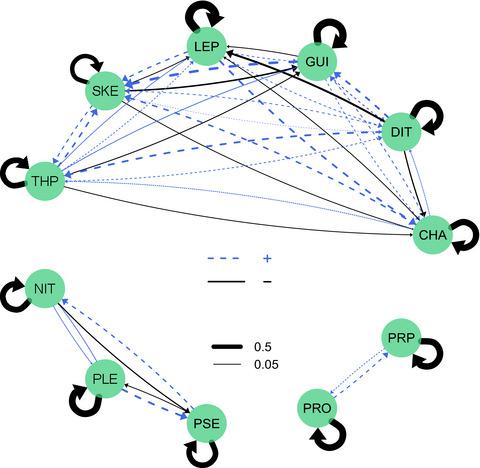Our official English website, www.x-mol.net, welcomes your
feedback! (Note: you will need to create a separate account there.)
Strong self‐regulation and widespread facilitative interactions in phytoplankton communities
Journal of Ecology ( IF 5.3 ) Pub Date : 2020-04-28 , DOI: 10.1111/1365-2745.13410 Coralie Picoche 1, 2 , Frédéric Barraquand 1, 2
中文翻译:

浮游植物群落中强大的自我调节和广泛的促进性相互作用
更新日期:2020-04-28
Journal of Ecology ( IF 5.3 ) Pub Date : 2020-04-28 , DOI: 10.1111/1365-2745.13410 Coralie Picoche 1, 2 , Frédéric Barraquand 1, 2
Affiliation

|
- The persistence of phytoplanktonic diversity in spite of competition for basic resources has long been a source of wonder and inspiration to ecologists. To sort out, among the many coexistence mechanisms suggested by theory and experiments, which ones actually maintain diversity in natural ecosystems, long‐term field studies are paramount.
- We analysed a large dataset of phytoplankton abundance time series using dynamic, multivariate autoregressive (MAR) models. Phytoplankton was counted and identified down to the genus level, every 2 weeks over 20 years, at 10 sites along the French coastline. MAR models allowed to estimate biotic interaction networks while also accounting for abiotic variables that may drive part of the phytoplankton fluctuations. We then analysed the ratio of intra to intertaxa interactions (a measure of niche differentiation), the frequency of negative versus positive interactions, and how stability metrics (both at the network and genus level) relate to network complexity and genus self‐regulation or abundance.
- We showed that a strong self‐regulation, with competition strength within a taxon (genus) an order of magnitude higher than between taxa, was present in all phytoplanktonic interaction networks. This much stronger intragenus competition suggests that niche differentiation—rather than neutrality—is commonplace in phytoplankton. Furthermore, interaction networks were dominated by positive net effects between phytoplanktonic taxa (on average, more than 50% of interactions were positive). While network stability (sensu resilience) was unrelated to complexity measures, we unveiled links between self‐regulation, intergenera interaction strengths and abundance. The less common taxa tend to be more strongly self‐regulated and can therefore maintain in spite of competition with more abundant ones.
- Synthesis. We demonstrate that strong niche differentiation, widespread facilitation between phytoplanktonic taxa and stabilizing covariances between interaction strengths should be common features of coexisting phytoplankton communities in the field. These are structural properties that we can expect to emerge from plausible mechanistic models of phytoplankton communities. We discuss mechanisms, such as predation or restricted microscale movement, that are consistent with these findings, which paves the way for further research.
中文翻译:

浮游植物群落中强大的自我调节和广泛的促进性相互作用
- 尽管争夺基本资源,但浮游植物多样性的持久性一直是生态学家的奇迹和灵感之源。综上所述,在理论和实验提出的许多共存机制中,哪些实际上保持了自然生态系统的多样性,长期的实地研究是最重要的。
- 我们使用动态,多元自回归(MAR)模型分析了浮游植物丰度时间序列的大型数据集。在20年的时间内,在法国海岸线上的10个地点,每2周对浮游植物进行计数并确定其属下水平。MAR模型可以估算生物相互作用网络,同时也可以考虑可能导致部分浮游植物波动的非生物变量。然后,我们分析了内群间相互作用的比率(一种利基分化的量度),负向相互作用和正向相互作用的频率,以及稳定性指标(在网络和属水平上)如何与网络复杂性以及属自我调节或富集相关。
- 我们表明,在所有浮游植物相互作用网络中都存在强大的自我调节能力,与一个分类群(类)内的竞争强度比一个分类群之间高一个数量级。这种更强的属内竞争表明,在浮游植物中,生态位分化而不是中立性很普遍。此外,相互作用网络以浮游植物类群之间的正净效应为主导(平均而言,超过50%的相互作用为正)。虽然网络稳定性(感知恢复能力)与复杂性度量无关,但我们揭示了自我调节,跨代交互强度和丰富度之间的联系。较不常见的分类单元往往具有更强的自我调节能力,因此尽管与较丰富的分类单元竞争也可以保持。
- 综合。我们证明了强大的生态位分化,浮游植物类群之间的广泛促进和相互作用强度之间的稳定协方差应该是该领域共存浮游植物群落的共同特征。这些是我们可能期望从浮游植物群落合理的力学模型中出现的结构特性。我们讨论了与这些发现一致的机制,例如掠食或微观活动受限,这为进一步的研究铺平了道路。











































 京公网安备 11010802027423号
京公网安备 11010802027423号